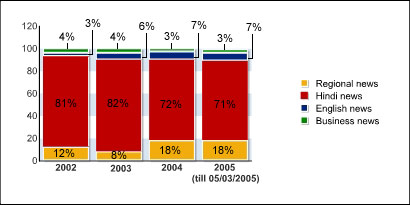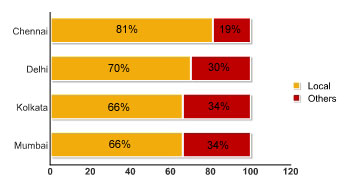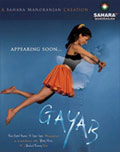Role of media vehicles
By Shubha Madhukar | 20 Aug 2005
In a media plan, each media vehicle has a significance and a role to play. Having the right mix of vehicles ensures meeting the objective of the campaign right.
Each medium used for advertising has a role to play. As Paulomi Dhawan, vice president, media and corporate communications, Raymond, puts it, "If print generates awareness and disseminates  information, television is a vehicle to build the brand with its visual and emotional appeal." Outdoor and radio work as reminder media, although outdoor advertising has been used heavily recently for creating initial awareness at the time of product launch. The internet is being used increasingly to provide detailed information, as a reminder medium, and for the interactivity and transactional facilities it offers.
information, television is a vehicle to build the brand with its visual and emotional appeal." Outdoor and radio work as reminder media, although outdoor advertising has been used heavily recently for creating initial awareness at the time of product launch. The internet is being used increasingly to provide detailed information, as a reminder medium, and for the interactivity and transactional facilities it offers.
Interestingly, using tools, media agencies claim, they can accurately foretell the effect of a certain advertising format in a certain media vehicle and the effectiveness of a given creative on the given target group.
Ad budget allocation is much more scientific today than it was, say, a decade-and-a-half ago. Tools are used at every stage to achieve campaign objectives and derive maximum effectiveness from the advertising.
 Television: In 2004, the ad spend on television was Rs5,428 crore (46 per cent of total ad spend in India), the highest ever as yet. The ad to content ratio varies from network to network but is mostly around 30:70. This gives ample airtime availability every day.
Television: In 2004, the ad spend on television was Rs5,428 crore (46 per cent of total ad spend in India), the highest ever as yet. The ad to content ratio varies from network to network but is mostly around 30:70. This gives ample airtime availability every day.
Each channel addresses a special segment in terms of demographics, behaviour and attitude. You might think that the fragmentation has so much clutter that it has become impossible for advertisers to choose the most effective spots in which to advertise.
Actually it is not. Talking about the clutter, Manish Porwal, executive director, India-west, Starcom, says, "Fragmentation is an opportunity, not a problem. If you have communication architects who know how to utilise that opportunity and put you in the right mix of vehicles and channels, you have got your audience anyway."
In fact, if there were just a single publication or channel cutting across all audiences, advertising niche products on the channel would be very expensive because it would result in an over-kill since a large part of the channel's audience is not part of the target group. Smart planning at the media agency can actually help advertisers to save money.
Media agencies have now begun to help clients to move their ads from the commercial breaks and into the programmes themselves. Advertisers who have smuggled themselves into programmes include SOTC, VLCC and ICICI Prudential. Top programmes like Kyunki saas bhi kabhi bahu thi on Star Plus and Jassi jaisi koi nahi on Sony have been more than happy to oblige.
Print: Ever since the 24x7 news channels made their way into India homes, speculation about the viability of the print media resurfaced. Curiously, recent statistics indicate that at least the leading print publications are doing well. According to Adex India, for the first time, in 2004, print has shown a growth of 17.40 per cent, compared with TV's 13 per cent.
And, if the launch of fat new newspapers is anything to go by, there is a lot of steam still left in the print business. In just two month in mid-2005, Mumbai witnessed the launch of three major newspapers — the Mumbai Mirror from the Bennett & Coleman stable, the Mumbai edition of the Hindustan Times, and the Dainik Bhaskar-Zee Television coalition's Daily News and Analysis, or DNA.

Three sectors — education (including coaching and vocational), real estate and hospitality — have driven revenue growths for print. These sectors advertise mostly in the local pages of newspapers.
More and more national dailies are printing local editions catalysing growth. Dainik Jagran, the No1 Hindi daily in India (readership: 212 million) has a presence in nine states and prints 27 editions. The Times of India, India's top English daily, has a local pullout every day besides domain-specific supplements.
The ad revenues of general interest and film magazines have either reached a plateau or dipped. However, niche magazines covering areas such as auto, IT and real estate have seen increased ad revenues. Advertisers find the "fragmentation" into niche areas a boon for reaching narrow target groups.
Radio: Think traditional radio advertising of the early days and the Dabur lal dant manjan jingle comes to mind. For long, the products advertised on radio were, by and large, those used by the rural folks and were meant for places where there was no electricity. Today, Bihar, Orissa and eastern Uttar Pradesh are the three radio-intensive areas and the medium is used to sell cycles and Lifebuoy soaps. But since they are on the periphery of the growing consumer class in India, these regions (and therefore radio) do not get much of the ad pie.
Now we have a new type of radio service, FM, which Porwal likes to describe as "a richer cousin of the regular radio". This medium is very popular with young consumers, who are hooked to it over the cellular phone. FM is also a part of the life of mature consumers driving to work daily.
FM is gaining acceptance amongst advertisers for another reason too. Pradeep Iyengar, vice president, west and south, adds, "It' cost-effective." The drawback: its reach is restricted to mostly metros and mini metros. The silver lining: the 10 million listeners are mostly consumer class.
Radio (including FM) received just Rs23.6 crore in advertising revenue in 2004. A little disappointing, being just 2 per cent of total ad spend — and considering the potential this medium has for effective local advertising. Now that the sector is being liberalised and a revenue sharing regime may replace the fixed license fee, and the second phase of privatisation from September-end 2005 will open up around 300 more markets for radio channels, this medium would be worth watching.

Source: Radio AdEx
Out-of-home (OOH): Out-of-home communication (on billboards and hoardings and on kiosks and buses) have usually been selected as supplementary reminder media playing second fiddle to TV and press advertising. Now, all of a sudden, outdoor advertising has been used in a more powerful way to launch products.
The newspaper DNA used outdoor advertising almost exclusively for spreading its launch message across the Mumbai conurbation. Earlier large companies like Reliance Infocomm, Hutch and Tata Indicom have used outdoor advertising massively to reach a large audience. As reminder medium nobody who has lived in major Indian city can forget the Amul hoardings, which people actually look forward to seeing.
The problem with outdoors has always been how to measure its effectiveness although it has found its way into the media plans of many advertisers. Now tracking OOH may soon become simpler.
 TAM, in collaboration with its partner Neilsen Outdoor, is testing "NMR Outdoor" — a Peoplemeter equivalent for outdoors — in Chicago. Says LV Krishnan, CEO, TAM Media Research, "NMR Outdoors, a small, lightweight device, will reside on a user's body and measure the user's location (including distance from outdoor sites), angle and time with the help of satellite-based GPRS." Essentially, this device will measure exposures to the hoardings or billboards based on the distance from and the angle at which the person is exposed to the particular creative.
TAM, in collaboration with its partner Neilsen Outdoor, is testing "NMR Outdoor" — a Peoplemeter equivalent for outdoors — in Chicago. Says LV Krishnan, CEO, TAM Media Research, "NMR Outdoors, a small, lightweight device, will reside on a user's body and measure the user's location (including distance from outdoor sites), angle and time with the help of satellite-based GPRS." Essentially, this device will measure exposures to the hoardings or billboards based on the distance from and the angle at which the person is exposed to the particular creative.
Outdoor advertising can cost as much as Rs21 lakh for a single hoarding on Patel Bridge on Marine Drive in Mumbai, or about Rs16 lakh at Heera Panna at Haji Ali in the same city. Steep as the rates may see, TV and print are much more expensive.
In its new role, outdoors is turning to the use of LED and Magnik. Communicating through the outdoor medium is a challenge. Since the outdoor media address a mobile audience, they require a unique creative: the copy should not exceed seven words and the concept should be absorbed in seven seconds.
No wonder there are companies like Ads Advertising and Outdoor Today, which specialise in outdoors. Media agencies like Starcom have a dedicated division, Star Sight, concentrating on outdoors.
Internet: Undoubtedly, this is the hot new field. Internet in India has 25 million users. The year-on-year growth in internet advertising in India has been 150 per cent. Of the total ad spend on the online space, 40 per cent has been from the financial
sector. The medium works very well with a premium audience.
Little wonder then that the banks are the biggest spenders online, closely followed by insurance companies and mutual funds, followed by IT and travel and tourism. The advantage these industries get online is of more clearly defined target groups, mostly educated and belonging mostly (approx 40 per cent) to SEC AB. The internet reaches a sizeable population (approx. 50 per cent) in the metros.
For industries with high-value products, addressing premium audiences online makes great sense. One hurdle for the medium is the constraint of reach. The moment it reaches critical mass here, FMCG may be the biggest spenders.
The first step forward in that direction is the formation of the Internet and Mobile Association of India (IAMAI), a governing body for the internet in India. IAMAI is presided over by Neville Taraporewala, chairman, Yahoo Web Services India Pvt Ltd; the member portals are MSN, Yahoo, Rediff, Indiatimes and Sify. The association is working with the objective of reaching 100 million users over the next two to three years. It would also be the authority in India to publish internet usage figures.
More and more clients are demanding that the internet be part of their media mix. Shamsuddin Jasani, manager, Mediaturf, says: "With internet you have interactivity. It is a response-generating mechanism. It enforces what one has seen on TV and radio."
Internet is also the medium, which is the most measurable. Jasani adds, "There is no sample size, there is the whole universe to work on. Since there is no extrapolation the measurements are 100 per cent correct."







.webp)














